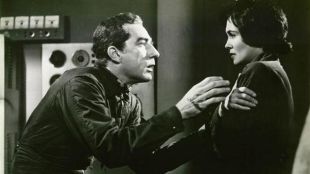Like a lot of B-movie producer/directors, Roger Corman was always eager to cash in on a real-life event. In the case of War Of The Satellites, he won this version of the "space race," getting it into theaters in the spring of 1958, barely a half-year after the Soviet Union launched Sputnik and sent the "Free World," as it was called then (and, especially, its newspapers), into a tizzy. Of course, what he delivered was a lot more fiction than science, as well as lacking in subtlety, but War Of The Satellites is great fun and the plot moves so fast that one barely has time to ask about some of the silliest aspects of what we see. Richard Devon is good enough as Dr. Van Ponder, the scientist behind the United Nations space program (actually a fairly forward-looking notion -- the US government didn't even "de-militarize" the real space program until later in 1958). And Dick Miller essays the role of a scientist and engineer with the same kind of two-fisted approach he brought to his college student hero in Corman's Sorority Girl (1957). As for his co-star Susan Cabot, she's good to look at but seems lost, as a method-trained actress with almost nothing to grab onto in terms of character, and absolutely no time for rehearsal -- the movie was reportedly written and produced in less than eight weeks, with less than 10 days devoted to actual shooting. One has to laugh at some of the production values, and marvel at others -- going to negative to depict moments where radiation (solar or otherwise) is at work is surprisingly effective. And cinematographer Floyd Crosby gets the most out of everything else (with the sections involving the Devon character''s last doppelganger appearance being especially eerie). The paintings depicting the rockets under construction also work well, and almost make one think of the better moments of such filmed television sci-fi shows of the era as Rocky Jones, Space Ranger. But the actual model work, apart from a few shots of the assembled satellite/space vehicle, is mostly a joke -- and the biggest hoot of all can be found in the sets, and the depiction of rockets and satellites that seem to have 20-foot cielings and enough room not only for a ridiculous array of corridors between them but living-room-size compartments. All of that is to smile at, along with an interlude near the beginning involving a couple of the oldest-looking college students in creation, witnessing an alien rocket landing. And in the midst of all of it is one of the most ambitious scores ever written by Walter Greene, a composer/music director who spent most of his career working on B-westerns and the Pink Panther cartoons. But what makes this movie more interesting to look at today than it could have at the time of its release are some of the notions brushed up against by the script. In a 66-minute picture there's not a lot of room for philosophizing -- but when Richard Devon's doppelganger is forced by circumstance to alter his internal physiology, to simulate a human heart and other internal organs, he suddenly finds himself feeling human emotions and even a kind of kinship with at least once crew-member. In a longer, more ambitious movie, this would have been a notion worth exploring by the writers and actors. And the idea of the whole universe opening up to us is a big leap from anything being discussed beyond philosophical scientific circles and some religious forums in 1958. One can find moments here that anticipate elements of Star Trek's plotting, and one of that show's scripts ("By Any Other Name"), as well as some ideas that show up in better developed form as installments of The Outer Limits.

War of the Satellites (1958)
Directed by Roger Corman
Genres - Science Fiction, Horror |
Sub-Genres - Alien Film, Sci-Fi Action |
Release Date - May 18, 1958 (USA - Unknown) |
Run Time - 66 min. |
Countries - United States |
MPAA Rating - NR
Share on